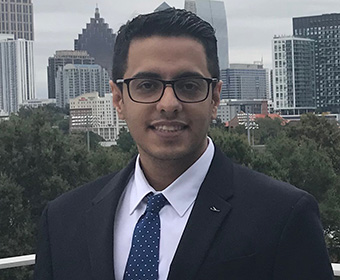
Mohammadali Sharzehee works in cardiovascular mechanics, a fast-growing field which combines mechanical engineering, biology and computer science to develop simulations of how blood vessels and other tubular organs work.
(Jan. 15, 2019) -- Mohammadali Sharzehee is a doctoral student in the UTSA Department of Mechanical Engineering who studies cardiovascular mechanics and builds computer simulations to understand how blood vessels operate under adverse conditions that lead to cardiovascular diseases.
In 2017, Sharzehee moved from Iran to the United States and started his Ph.D. program at UTSA. He found quick success and a few months later published an analysis in the Journal of Computer Methods in Biomechanics and Biomedical Engineering of how arteries, the blood vessels that carry oxygen-rich blood from the heart, lose their resiliency and lead to aneurysms.
UTSA Today spoke to Sharzehee about his “tubular” work:
Why do you study a field that combines engineering but also the human body?
Cardiovascular biomechanics is a fast-growing field of engineering and improves the understanding, treatment and prevention of cardiovascular diseases. It also plays a crucial role in the development of the medical devices by applying mechanical engineering principles to cardiovascular system.
You focus on how arteries in our bodies twist into loops and spirals during negative conditions. Why do you want to study this field?
Vascular tortuosity or twists may result in an ischemic attack—a restriction in blood supply—to distal organs as well as other negative changes related to diseases. This research has an important impact on clinical work and, because of that, I became motivated to better understand the mechanisms of arteries.
What does your work intend to show?
My work aims to determine the biomechanical loads or conditions that trigger the occurrence of tortuous blood vessels using computational modeling. In addition, my results illustrate the effects of vessel dimensions, material models and properties, and mechanical loadings conditions on formation of tortuous vessels—curving, coiling, kinking and looping.
How is your research beneficial to people?
Our computational model can be applied to any tubular organ, including the esophagus and the stomach, and even vascular implants including grafts and stents. Considering the torsional and bending stability of blood vessels and vascular grafts, this is important for future designs of vascular implant and treatments in vascular disease.
How did you get into this type of research? Was there a turning point -- an “a ha” moment?
Our research group, under the supervision of Dr. Hai-Chao Han, has conducted a number of artery buckling experiments. During those experiments, we observed tortuous vessels but the “how” or the mechanics of artery helical buckling remained unclear. Dr. Han explained the problem to me, and I decided solve the question with computational modeling. After one year of hard work, we have finally completed the work and submitted our manuscript to peer-reviewed journals.
Why did you choose UTSA?
I chose UTSA to work with Dr. Han, whose research piqued my interest. I believe that his guidance will pave the way for my future academic success.
What keeps you up at night?
Despite grueling and frustrating work, my enthusiasm for academic research to make scientific breakthroughs keeps me motivated during my Ph.D.
What’s next?
Currently, I am working on another cardiovascular disease (myocardial bridge) in which a segment of the coronary artery is covered by a muscle bridge that can lead to transient vessel compression. I want to enhance the understanding and treatment of this disease to improve the quality of life for people.
Learn more about the Han Lab.
Learn more about the UTSA Department of Mechanical Engineering.
Celebrate UTSA’s 50th Anniversary and share social media posts about the 50th using the hashtag #UTSA50.
Connect with UTSA online at Facebook, Twitter, YouTube, Instagram and LinkedIn.
UTSA Today is produced by University Communications and Marketing, the official news source of The University of Texas at San Antonio. Send your feedback to news@utsa.edu. Keep up-to-date on UTSA news by visiting UTSA Today. Connect with UTSA online at Facebook, Twitter, Youtube and Instagram.
Move In To COLFA is strongly recommended for new students in COLFA. It gives you the chance to learn about the Student Success Center, campus resources and meet new friends!
Academic Classroom: Lecture Hall (MH 2.01.10,) McKinney Humanities BldgWe invite you to join us for Birds Up! Downtown, an exciting welcome back event designed to connect students with the different departments at the Downtown Campus. Students will have the opportunity to learn about some of the departments on campus, gain access to different resources, and collect some giveaways!
Bill Miller PlazaCome and celebrate this year's homecoming at the Downtown Campus with food, games, giveaways, music, and more. We look forward to seeing your Roadrunner Spirit!
Bill Miller PlazaThe University of Texas at San Antonio is dedicated to the advancement of knowledge through research and discovery, teaching and learning, community engagement and public service. As an institution of access and excellence, UTSA embraces multicultural traditions and serves as a center for intellectual and creative resources as well as a catalyst for socioeconomic development and the commercialization of intellectual property - for Texas, the nation and the world.
To be a premier public research university, providing access to educational excellence and preparing citizen leaders for the global environment.
We encourage an environment of dialogue and discovery, where integrity, excellence, respect, collaboration and innovation are fostered.